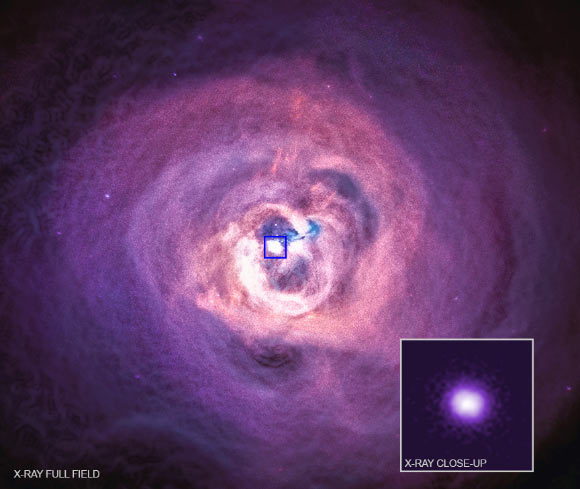Astrophysicists Perform Test of String Theory | Astronomy – Sci-News.com
Astrophysicists using NASA’s Chandra X-ray Observatory have looked for signs of an as-yet undetected particle predicted by string theory, a set of models intended to tie together all known forces, particles, and interactions.

Reynolds et al used Chandra to look for extraordinarily low-mass axion-like particles in the Perseus galaxy cluster, a group of galaxies located 240 million light-years away from Earth. The observation lasting over five days showed no evidence for certain axion-like particles, which some theorists think can explain dark matter. The lack of detection in these Chandra observations helps rule out some versions of string theory, a set of models intended to tie together all known forces, interactions, and particles. Image credit: NASA / CXC / University of Cambridge / Reynolds et al.
“Until recently I had no idea just how much X-ray astronomers bring to the table when it comes to string theory, but we could play a major role. If these particles are eventually detected it would change physics forever,” said study’s lead author Dr. Christopher Reynolds, a researcher at the University of Cambridge.
The particle that Dr. Reynolds and colleagues were searching for is called an axion.
This as-yet-undetected particle should have extraordinarily low mass. Theoretical physicists do not know the precise mass range, but many theories feature axion masses ranging from about a millionth of the mass of an electron down to zero mass.
Some scientists think that axions could explain the mystery of dark matter, which accounts for the vast majority of matter in the universe.
One unusual property of this ultra-low-mass particle would be that it might sometimes convert into photons (that is, packets of light) as they pass through magnetic fields. The opposite may also hold true: photons may also be converted into axions under certain conditions.
How often this switch occurs depends on how easily they make this conversion, in other words on their ‘convertibility.’
Some scientists have proposed the existence of a broader class of ultra-low-mass particles with similar properties to axions.
Axions would have a single convertibility value at each mass, but ‘axion-like particles’ would have a range of convertibility at the same mass.
“While it may sound like a long shot to look for tiny particles like axions in gigantic structures like galaxy clusters, they are actually great places to look,” said study’s co-author Dr. David Marsh, a researcher at Stockholm University.
“Galaxy clusters contain magnetic fields over giant distances, and they also often contain bright X-ray sources. Together these properties enhance the chances that conversion of axion-like particles would be detectable.”
To look for signs of conversion by axion-like particles, the astrophysicists examined over five days of Chandra observations of X-rays from material falling towards the supermassive black hole in the center of NGC 1275, the central galaxy of the Perseus galaxy cluster.
They studied the Chandra spectrum, or the amount of X-ray emission observed at different energies, of this source.
The long observation and the bright X-ray source gave a spectrum with enough sensitivity to have shown distortions that scientists expected if axion-like particles were present.
The lack of detection of such distortions allowed the researchers to rule out the presence of most types of axion-like particles in the mass range their observations were sensitive to, below about a millionth of a billionth of an electron’s mass.
“Our research doesn’t rule out the existence of these particles, but it definitely doesn’t help their case,” said study’s co-author Dr. Helen Russell, a researcher at the University of Nottingham.
“These constraints dig into the range of properties suggested by string theory, and may help string theorists weed their theories.”
The results appear in the Astrophysical Journal.
_____
Christopher S. Reynolds et al. 2020. Astrophysical Limits on Very Light Axion-like Particles from Chandra Grating Spectroscopy of NGC 1275. ApJ 890, 59; doi: 10.3847/1538-4357/ab6a0c





